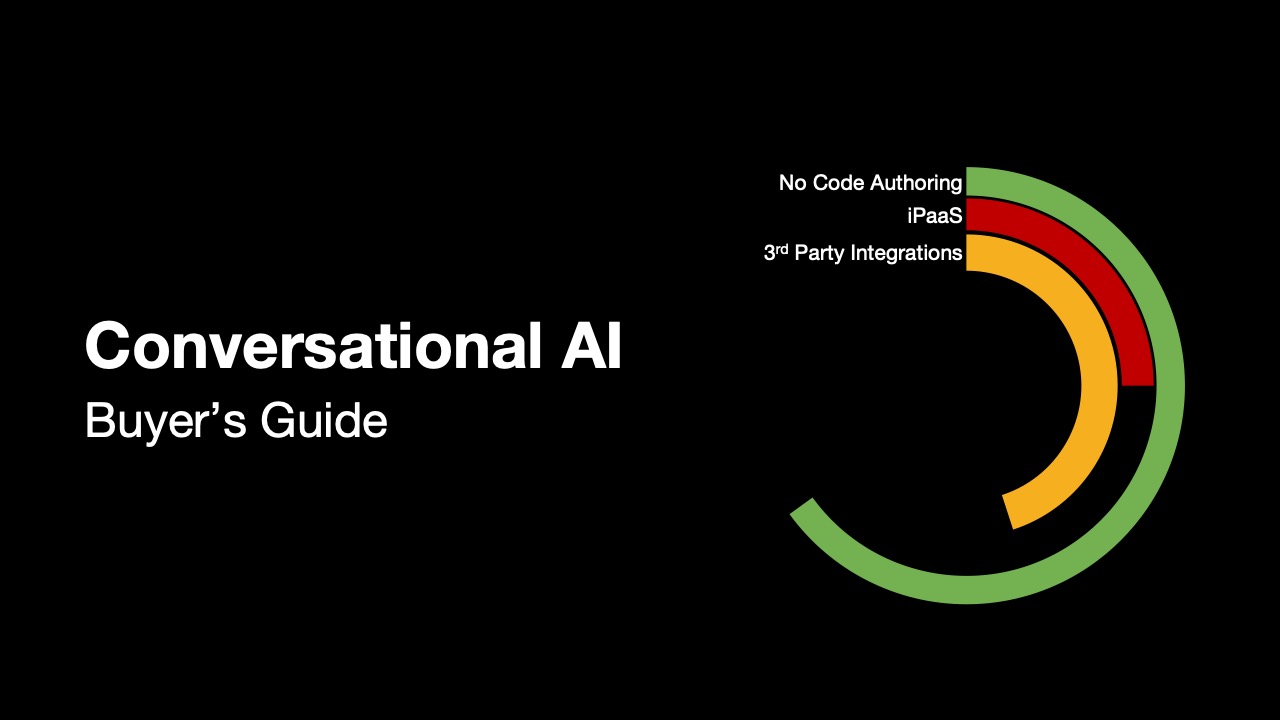Have you ever been a part of a roundtable discussion that felt more like a dinner with friends? That was the atmosphere during a meeting we hosted in early March. In this session, we brought together some of the industry’s brightest automation professionals to discuss some of their challenges when it comes to intelligent automation.
At the onset of the session, John Michelsen made it a point to emphasize that this session wasn’t about a Krista sales pitch, nor was it necessarily about success stories, but rather what we could all do better to create technology humans easily understand. To make the session as interactive as possible, we provided topics our experts could vote on and rank from their mobile devices. We then encouraged an open floor to discuss the results.
Some of the findings that we gathered may surprise you:
Which Automation Tasks are the Most Difficult?
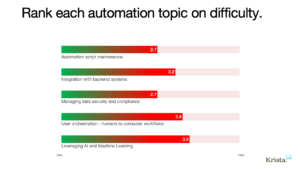 To kick things off, we asked our experts to rank different automation topics on difficulty. The most difficult was ‘Leveraging AI and Machine Learning,’ but tailing closely behind was ‘User orchestration- humans to computer workflows.’ This tells us there are disconnects between what the tech is doing and how to make it work with the humans on the other side seamlessly and effortlessly.
To kick things off, we asked our experts to rank different automation topics on difficulty. The most difficult was ‘Leveraging AI and Machine Learning,’ but tailing closely behind was ‘User orchestration- humans to computer workflows.’ This tells us there are disconnects between what the tech is doing and how to make it work with the humans on the other side seamlessly and effortlessly.
What is the most difficult aspect of maintaining automation?
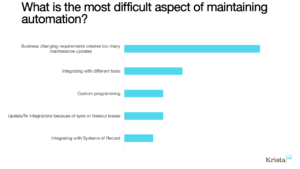 For this question, respondents overwhelmingly said that the most challenging part was that businesses changing requirements create too many maintenance updates. The second-highest choice was integration with different tools. “We in the development community can never keep up with the mouth of the business…they can talk faster than we can code!” When talking about the relationship between the business and its developers, John said, “Self-healing style testing is going to be the way of the future.”
For this question, respondents overwhelmingly said that the most challenging part was that businesses changing requirements create too many maintenance updates. The second-highest choice was integration with different tools. “We in the development community can never keep up with the mouth of the business…they can talk faster than we can code!” When talking about the relationship between the business and its developers, John said, “Self-healing style testing is going to be the way of the future.”
What enterprise/compliance issues are the most challenging?
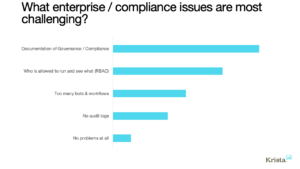 There’s no doubt that compliance is a big conversation in the development community; so much of this role has to do with ensuring compliance starts at the back-end. For this question, the answer that ranked as the most difficult was governance and compliance documentation. During the discussion in the wake of this question, John made a good point when he said, “We worry about this a lot. A lot of the tech is not really constructed in such a way that helps you with ‘Oh, that’s a salary, you’d better be careful who you show that to’…we think that’s a lot harder to do than it really ought to be.”
There’s no doubt that compliance is a big conversation in the development community; so much of this role has to do with ensuring compliance starts at the back-end. For this question, the answer that ranked as the most difficult was governance and compliance documentation. During the discussion in the wake of this question, John made a good point when he said, “We worry about this a lot. A lot of the tech is not really constructed in such a way that helps you with ‘Oh, that’s a salary, you’d better be careful who you show that to’…we think that’s a lot harder to do than it really ought to be.”
Where does automation bottleneck or stop because of users?
 This is a very near and dear question to our hearts; our whole mission is to bring conversation to automation and improve the DevOps experience. Here, our experts answered that the area where they have the most difficulty is when it comes to integrating automations across two roles or departments.
This is a very near and dear question to our hearts; our whole mission is to bring conversation to automation and improve the DevOps experience. Here, our experts answered that the area where they have the most difficulty is when it comes to integrating automations across two roles or departments.
Coming in at a close second was the inability for automations to interact with humans. What makes these findings so fascinating is the common recurring theme of the relationship between humans and technology. Our guests had some great insights into this throughout the session, sharing their own experiences with the problems they face daily and even more so about the solutions.
John summarized it best when he said, “I have a philosophy that we need to get automation to a much more people-friendly, people-centric, not tech-centric kind of approach. And in that regard, we find that it’s difficult to do if it isn’t connecting people and automation.”
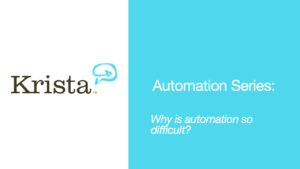 We strive to make our sessions interactive where participants are an active part of the discussion instead of passive listeners. To view the complete question and answer results, please click here.
We strive to make our sessions interactive where participants are an active part of the discussion instead of passive listeners. To view the complete question and answer results, please click here.


